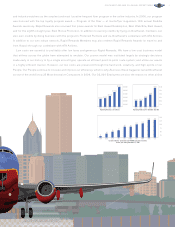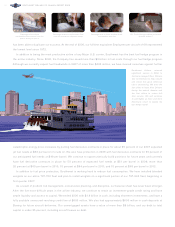Southwest Airlines 2006 Annual Report Download - page 20
Download and view the complete annual report
Please find page 20 of the 2006 Southwest Airlines annual report below. You can navigate through the pages in the report by either clicking on the pages listed below, or by using the keyword search tool below to find specific information within the annual report.
PART I
Item 1. Business
Overview
Southwest Airlines Co. is a major passenger airline
that provides scheduled air transportation in the United
States. Based on the most recent data available from the
Department of Transportation, Southwest Airlines is the
largest carrier in the United States, as measured by
originating passengers boarded and scheduled domestic
departures. Southwest was incorporated in Texas in 1967
and commenced Customer Service on June 18, 1971,
with three Boeing 737 aircraft serving three Texas cit-
ies — Dallas, Houston, and San Antonio. At year-end
2006, Southwest operated 481 Boeing 737 aircraft and
provided service to 63 cities in 32 states throughout the
United States. During 2006, the Company began service
to Denver, Colorado, and Washington Dulles Interna-
tional Airport. The terms “Southwest,” the “Company,”
“we,” “us,” and similar terms refer to Southwest Airlines
Co. and its subsidiaries.
Southwest focuses principally on point-to-point,
rather than hub-and-spoke, service, providing its markets
with frequent, conveniently timed flights and low fares.
At December 31, 2006, Southwest served 397 nonstop
city pairs. Historically, Southwest has served predomi-
nantly short-haul routes, with high frequencies. In recent
years, the Company has complemented this service with
more medium to long-haul routes, including transconti-
nental service.
One of Southwest’s primary competitive strengths is
its low operating costs. Southwest has the lowest costs,
adjusted for stage length, on a seat mile basis, of all the
major airlines. Among the factors that contribute to its
low cost structure are a single aircraft type, an efficient,
high-utilization, point-to-point route structure, and
hardworking, innovative, and highly productive
Employees.
The business of the Company is somewhat seasonal.
Quarterly operating income and, to a lesser extent, rev-
enues tend to be lower in the first quarter (January 1 -
March 31) and fourth quarter (October 1 - Decem-
ber 31) of most years.
Southwest’s annual report on Form 10-K, quarterly
reports on Form 10-Q, current reports on Form 8-K, and
amendments to those reports that are filed with or fur-
nished to the SEC, are accessible free of charge at
www.southwest.com as soon as reasonably practicable
after they are electronically filed with, or furnished to,
the SEC.
Fuel
The cost of fuel is an item that has significant
impact on the Company’s results of operations. The
Company’s average cost of jet fuel, net of hedging gains
and excluding fuel taxes, over the past five years was as
follows:
Year
Cost
(Millions)
Average Cost
Per Gallon
Percent of
Operating Expenses
2002 . . $ 762 $ .68 14.7%
2003 . . $ 830 $ .72 14.9%
2004 . . $1,000 $ .83 16.3%
2005 . . $1,341 $1.03 19.6%
2006 . . $2,138 $1.53 26.2%
From October 1, 2006 through December 31,
2006, the average cost per gallon was $1.55. Fuel costs
and Southwest’s fuel hedging activities are discussed in
more detail below under “Risk Factors” and “Manage-
ment’s Discussion and Analysis of Financial Condition
and Results of Operations.”
Regulation
Economic.
•Department of Transportation. The Department
of Transportation (“DOT”) has significant regu-
latory jurisdiction over passenger airlines. To pro-
vide passenger transportation in the United States, a
domestic airline is required to hold a certificate of
public convenience and necessity issued by the
DOT. A certificate is unlimited in duration and
generally permits the Company to operate among
any points within the United States, its territories
and possessions. The DOT may revoke a certificate,
in whole or in part, for intentional failure to comply
with federal aviation statutes, regulations, orders, or
the terms of the certificate itself. The DOT also has
jurisdiction over certain economic and consumer
protection matters such as advertising, denied
boarding compensation, baggage liability, and
access for persons with disabilities. The DOT
may impose civil penalties on air carriers for viola-
tions of its regulations in these areas.
•Wright Amendment. The International Air
Transportation Competition Act of 1979, as
amended (the “Act”), includes restrictions on
the provision of air transportation to and from
Dallas Love Field. The applicable portion of the
Act, commonly known as the “Wright Amend-
ment,” as it affects Southwest’s scheduled service,
has prohibited carrying nonstop and through pas-
sengers on commercial flights between Dallas Love
1
























